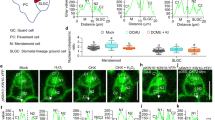Abstract
Changes in the spacing patterns of Ca-oxalate crystals during enlargement ofCarya ovata Mill. leaves were quantified by computerized image-analysis. Single Ca-oxalate crystals form in the vacuoles of young mesophyll cells transformed into crystal cells Crystals are very small in newly induced crystal cells and increase in size throughout leaf development. Crystal patterns thus reflect both induction and relative age of crystal cells. Shortly after the emergence of young leaves from the bud, very small crystals are formed in the mesophyll at high density. As leaves expand, these crystals grow larger and become separated by increasing distances. New small crystals appear in the gaps between the older, larger crystals. Later crystal patterns consist of widely spaced, larger crystals only. Finally, clusters of small crystals are formed again in the gaps between large crystals. No crystals were observed in young leaves expanding in a moist chamber, but large numbers of crystal cells were induced experimentally in sections of immature leaves floating on 4 mM Ca-acetate. The observations support the following mechanism of crystal-pattern formation: Ca2+ carried into leaves with the transpiration stream acts as the developmental signal inducing transdifferentiation of a few mesophyll cells into crystal cells when apoplastic [Ca2+] rises. Crystal cells precipitate absorbed Ca2+ as oxalate and, acting as Ca2+ sinks, inhibit crystal-cell induction in their vicinity by depleting apoplastic Ca2+. This prevents close spacing of crystal cells. New crystal cells form in the gaps between the depletion zones of older crystal cells when these move apart during leaf expansion. Later changes in crystal patterns result from increasing sink strength of crystal cells, lowered inducibility of mesophyll cells, and increased Ca2+ influx into leaves during intensive transpiration. Throughout leaf development, spacing of crystal cells permits rapid secretion of apoplastic Ca2+ as Ca-oxalate.
Similar content being viewed by others
References
Arnott, H.J. (1980) An SEM study of crystal idioblasts in pecan leaves. Scan. Electr. Mic.1980/III, 563–569
Borchert, R. (1984) Functional anatomy of the calcium-excreting system ofGleditsia triacanthos L. Bot. Gaz.145, 184–195
Borchert, R. (1985) Calcium-induced pattern of calcium oxalate crystals in isolated leaflets ofGleditsia triacanthos L. andAlbizia julibrissin Durazz. Planta165, 301–310
Borchert, R. (1986) Calcium acetate induces calcium uptake and formation of calcium oxalat crystals in isolated leaflets ofGleditsia triacanthos L. Planta168, 571–578
Bünning, E. (1965) Die Entstehung von Mustern in der Entwicklung von Pflanzen. In: Encyclopedia of plant physiology, vol. XV, pt. 1, pp. 383–408, Ruhland, W. ed Springer, Berlin Heidelberg New York
Clarkson, D.T. (1984) Calcium transport between tissues and its distribution in the plant. Plant Cell Environ.7, 449–456
Korn, R.W. (1981) A neighboring-inhibition model for stomatal patterning. Dev. Biol.88, 115–120
Leick, E. (1955) Periodische Neuanlage von Blattstomata. Flora142, 45–64
Meinhardt, H. (1982) Models of biological pattern formation. Academic Press, London
Nobel, P.S. (1983) Biophysical plant physiology and ecology, Freeman, San Francisco
Napp-Zinn, K. (1973) Anatomie des Blattes. Blattanatomie der Angiospermen. In: Encyclopedia of plant anatomy, vol. VIII, pt. 2A, Linsbauer, K., ed. Gebr. Bornträger Berlin
Pielou, E.C. (1974) Population and community ecology. Gordon and Breach Science Publishers, New York
Sachs, T. (1978) The development of spacing patterns in the leaf epidermis. Symp. Soc. Dev. Biol.36, 161–183
Sachs, T. (1984) Control of cell patterns in plants. In: Pattern formation, pp. 367–391, Malacinski, G.M., Bryan, S.V., eds. Macmillan, New York
Sachs, T. (1988) Epigenetic selection: an alternative mechanism of pattern formation. J. Theor. Biol.134, 547–559
Spurr, A.R. (1969) A low-viscosity epoxy resin embedding medium for electron microscopy. J Ultrastruct. Res.26 31–34
Wolpert, L., Stein, W.D. (1984) Positional information and pattern formation. In: Pattern formation, pp. 3–21, Malacinski, G.M., Bryan, S.V., eds. Macmillan, New York
Zindler-Frank, E., Wichmann, E., Korneli, M. (1988). Cells with crystals of calcium oxalate in the leaves ofPhaseolus vulgar −a comparison with those inCanavalia ensiformis. Bot. Acta101, 246–253
Author information
Authors and Affiliations
Additional information
Dedicated to Professor Erwin Bünning, University of Tübingen, Germany, who pioneered the analysis of spacing patterns
Rights and permissions
About this article
Cite this article
Borchert, R. Ca2+ as developmental signal in the formation of Ca-oxalate crystal spacing patterns during leaf development inCarya ovata . Planta 182, 339–347 (1990). https://doi.org/10.1007/BF02411383
Received:
Accepted:
Issue Date:
DOI: https://doi.org/10.1007/BF02411383




